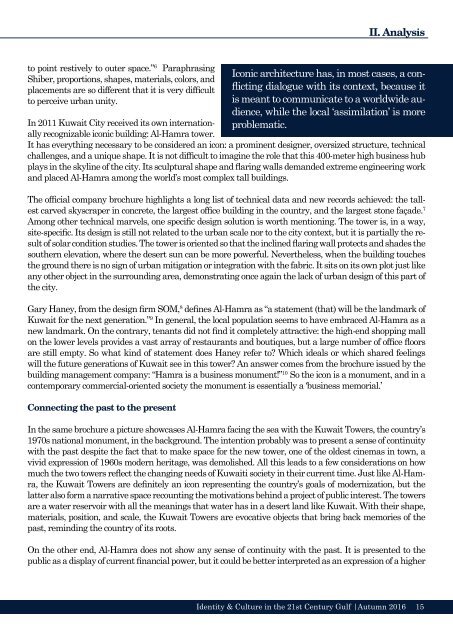Create successful ePaper yourself
Turn your PDF publications into a flip-book with our unique Google optimized e-Paper software.
II. Analysis<br />
to point restively to outer space.” 6 Paraphrasing<br />
Shiber, proportions, shapes, materials, colors, and<br />
placements are so different that it is very difficult<br />
to perceive urban unity.<br />
In 2011 Kuwait City received its own internationally<br />
recognizable iconic building: Al-Hamra tower.<br />
It has everything necessary to be considered an icon: a prominent designer, oversized structure, technical<br />
challenges, and a unique shape. It is not difficult to imagine the role that this 400-meter high business hub<br />
plays in the skyline of the city. Its sculptural shape and flaring walls demanded extreme engineering work<br />
and placed Al-Hamra among the world’s most complex tall buildings.<br />
The official company brochure highlights a long list of technical data and new records achieved: the tallest<br />
carved skyscraper in concrete, the largest office building in the country, and the largest stone façade. 7<br />
Among other technical marvels, one specific design solution is worth mentioning. The tower is, in a way,<br />
site-specific. Its design is still not related to the urban scale nor to the city context, but it is partially the result<br />
of solar condition studies. The tower is oriented so that the inclined flaring wall protects and shades the<br />
southern elevation, where the desert sun can be more powerful. Nevertheless, when the building touches<br />
the ground there is no sign of urban mitigation or integration with the fabric. It sits on its own plot just like<br />
any other object in the surrounding area, demonstrating once again the lack of urban design of this part of<br />
the city.<br />
Gary Haney, from the design firm SOM, 8 defines Al-Hamra as “a statement (that) will be the landmark of<br />
Kuwait for the next generation.” 9 In general, the local population seems to have embraced Al-Hamra as a<br />
new landmark. On the contrary, tenants did not find it completely attractive: the high-end shopping mall<br />
on the lower levels provides a vast array of restaurants and boutiques, but a large number of office floors<br />
are still empty. So what kind of statement does Haney refer to? Which ideals or which shared feelings<br />
will the future generations of Kuwait see in this tower? An answer comes from the brochure issued by the<br />
building management company: “Hamra is a business monument!” 10 So the icon is a monument, and in a<br />
contemporary commercial-oriented society the monument is essentially a ‘business memorial.’<br />
Connecting the past to the present<br />
Iconic architecture has, in most cases, a conflicting<br />
dialogue with its context, because it<br />
is meant to communicate to a worldwide audience,<br />
while the local ‘assimilation’ is more<br />
problematic.<br />
In the same brochure a picture showcases Al-Hamra facing the sea with the Kuwait Towers, the country’s<br />
1970s national monument, in the background. The intention probably was to present a sense of continuity<br />
with the past despite the fact that to make space for the new tower, one of the oldest cinemas in town, a<br />
vivid expression of 1960s modern heritage, was demolished. All this leads to a few considerations on how<br />
much the two towers reflect the changing needs of Kuwaiti society in their current time. Just like Al-Hamra,<br />
the Kuwait Towers are definitely an icon representing the country’s goals of modernization, but the<br />
latter also form a narrative space recounting the motivations behind a project of public interest. The towers<br />
are a water reservoir with all the meanings that water has in a desert land like Kuwait. With their shape,<br />
materials, position, and scale, the Kuwait Towers are evocative objects that bring back memories of the<br />
past, reminding the country of its roots.<br />
On the other end, Al-Hamra does not show any sense of continuity with the past. It is presented to the<br />
public as a display of current financial power, but it could be better interpreted as an expression of a higher<br />
<strong>Identity</strong> & <strong>Culture</strong> in the 21st Century Gulf |Autumn 2016 15


